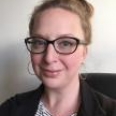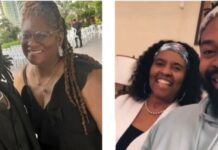Researchers use crisis informatics to investigate people’s specific concerns with COVID-19, how they gather info
How we use technology reveals a lot about us, especially in times of crisis. Over the past year, ASU College of Health Solutions Assistant Professor Katie Pine and colleagues leveraged that fact to investigate the intensive “risk work” being conducted by individuals amid the COVID-19 pandemic.
In a paper published recently in the Proceedings of the ACM Conference on Human Factors in Computational Systems, Pine and fellow researchers from George Mason University, University of California, Irvine and the Australian National University detail findings that reveal not only how people in the U.S. perceived pandemic-related risks but how they gathered information to assess and manage them.
Their study, rooted in the field of crisis informatics, was funded by the ASU Knowledge Exchange for Resilience.
“Crisis informatics is a really fascinating area of study pioneered by Professor Leysia Palen at the University of Colorado, Boulder,” Pine said. “It looks at how people are using emerging technologies to manage crises. Broadly, it is a field of study that examines interconnections between information, people, technology and formal and informal organizations during crises and disasters.”
Pine and her team interviewed 40 participants selected for diversity (age, geographic location and self-reported difficulties faced during the pandemic) from across the U.S. and found a surprising variety in the nature of their concerns about COVID-19, as well as a lack of trust in the information coming from most major news sources.
Pine shared with ASU News where people turned to for news instead, and how we might leverage that knowledge in the future.
Question: What were the most common concerns you found people had around COVID-19?
Answer: The most common concerns people had around COVID-19 were illness and economic risks. But that wasn’t all, and The Conversation piece we published about the study points out that people conceive of COVID-19 risks as more diverse and complex than popular narratives about managing “health versus the economy” suggest.
One thing I thought was really interesting was that people were really concerned about delays in life trajectories. Another thing that was interesting was that we identified these five categories of risk that all interacted with each other, that people were really struggling to balance. For instance, we interviewed a participant who was food insecure because she lost one of her jobs, so she was on food stamps. And she had to decide whether or not it was worth the risk of taking the bus and being in close proximity to people outside of her household so that she could go to the farmers market and get fresh produce, or whether she should just walk by herself to the local convenience store where the food was less healthy.
We also found people were delaying health care needs because they were terrified to go to the doctor and possibly expose themselves. One person we interviewed got a bad cut on her foot, and instead of going to the ER, she had her boyfriend call a friend of his who was a paramedic to come over to her house and stitch up her foot.
Q: What were the five categories of risk you identified?
A:
- COVID-19 illness.
- Secondary illness as a result of not being able to access health care because all resources are being put toward COVID-19.
- Sociobehavioral and relationship risks, such as mental illness, isolation and estrangement.
- Economics risks, such as a potential recession and/or job and income loss.
- Crumbling institutions. So people were worried we would lose things that support a healthy society, like museums and institutions of education and government. For example, some people were worried about losing their constitutional right to privacy.
Video courtesy of Katie Pine
Q: What did you discover about how people were getting information about COVID-19?
A: As we were looking at information sources, we realized the environment people were in was really important. Because one of the most common ways people were getting their information was through their own, small-world networks — so their own personal contacts. That was super-influential in shaping risk perception. For example, one participant said he was so overwhelmed by the news, so every day he would just have his wife report the news to him. Then a lot of people talked about having these ongoing group chats, either texting or direct messaging friends. And a lot of these group chats would center on an “expert” in some sense; so people would contact other people in their network who were health care workers, for example, and ask what they thought or how things were looking from their perspective.
Q: Do you have any idea why people felt less inclined to get their information from the news rather than someone they knew?
A: One of the problems people had with getting COVID-19 information from the news was that they felt like they needed information about specific circumstances, and they weren’t getting that. For instance, they might just want to know if their baby is at risk, or if their dad quarantines for two weeks, is that enough time for him to be safe to visit? So I think by reaching out to experts in their own personal networks, people were trying to get a more contextualized take on their own specific circumstances. They were sort of using human filters to determine risk.
Q: What can we learn from that? How can we leverage that knowledge to do a better job for the next crisis?
A: One thing I thought was interesting that my colleagues and I noted, because we interviewed some clinicians, too, was those folks are doing a lot of informal work as far as direct communication with the general public. So there’s certainly potential for future investigation there, as far as how we can try to support these small-world networks as key information sources. Maybe when clinicians get daily updates at their workplace about changing COVID conditions, they could share that with people in their own small-world networks. It’d be interesting to see if there’s a way to support that labor and use it as a better way to communicate all this complex information, because people really seem to trust that.
Top photo courtesy of Pixabay


The College of Liberal Arts and Sciences at Arizona State University offers a variety of courses on gender and sexuality as well as lesbian, gay, bisexual, transgender and queer/questioning (LGBTQ) studies. Whether you’re interested in exploring gender in the media or delving into human sexuality, you can expand your knowledge this summer and fall with these featured courses from The College.
Visit ASU’s Community Resources page to find additional resources and services available to the LGBTQ+ community.
1. COM 442: Identity, Performance and Human Communication (Fall T/Th, 1:30–2:45 p.m.): Explore communication dimensions of self and others including gender, race, sexuality, age and ethnicity through performance in this course from the Hugh Downs School of Human Communication with Assistant Professor Benjamin LeMaster.
2. FAS 264: Gender and Society (Fall T/Th, noon–1:15 p.m.): In this course from the Sanford School of Social and Family Dynamics taught by Lecturer Casey Sechler, you’ll analyze the development, nature and consequences of gender in contemporary society.
3. FMS 375: LGBTV: Television and Sexuality (Fall T/Th, noon–1:15 p.m.): Delve into LGBT representation on reality shows, sitcoms and dramas in relation to the economic and regulatory structures of the TV business to understand the complex functions of sexual identity in the television industry with Julia Himberg, associate professor and director of Film and Media Studies.
4. REL 205 — Life, Sex and Death (Fall T/Th, noon–1:15 p.m.): In this course from the School of Historical, Philosophical and Religious Studies, you will explore the ways that religions have understood birth, sexuality, death and the passing of generations by analyzing examples from traditions throughout the world with Associate Professor Miguel Aguilera.
Seats in the courses below may be reserved for graduate students or students in specified programs, majors or groups.
5. AIS 511: Genders and Sexualities in American Indian Societies (Fall T, 4:50–7:35 p.m.): In American Indian societies, there were traditionally more than two genders. With colonization through laws, boarding schools and loss of culture, language and land, these different genders were attacked and made to disappear. In this graduate-level course from American Indian Studies, you’ll examine the concepts of gender and sexuality from Native perspectives and Western imperial views with Director of Graduate Studies and Associate Professor Myla Vicenti Carpio.
6. ASB 210: Human Sexuality – Anthropological Perspectives (Fall, iCourse): Learn to examine the sexual nature and behavior of humans from both a biological and an anthropological point of view across various cultures around the globe in this course from the School of Human Evolution and Social Change taught by Instructor Laura Bidner.
7. COM 316: Gender and Communication (Fall W, 6–8:45 p.m.): In this course taught by graduate teaching associate Marco Dehnert, you’ll gain an understanding of gender-related communication by examining verbal, nonverbal and paralinguistic differences and similarities through social, psychological and historical perspectives.
8. FAS 332: Human Sexuality (Summer, iCourse): Delve into the relationship of sexuality to family life and other major societal issues with Instructor M. Brougham.
9. SST 294: Introduction to LGBTQ History and Culture (Fall, iCourse): Discuss the historical context of racism and transphobia in the LGBTQ civil rights movement and explore creative works including literature and visiual media from queer and transgender people in the United States with Assistant Professor Mellissa Linton in the School of Social Transformation.
10. WST 460: Women and the Body (Summer, ASU Online): Conduct an in-depth analysis of the cultural construction of the gendered body and societal prescriptions about beauty, body image and size in this women’s studies course from the School of Social Transformation with graduate teaching assistant Hannah Grabowski.
This is not an exhaustive list of courses offered on topics of gender and sexuality available. Browse the full offering of courses.









